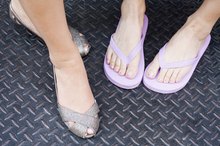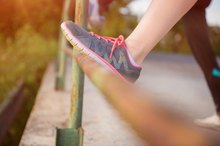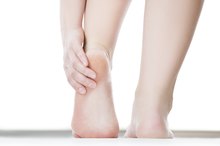What does fact checked mean?
At Healthfully, we strive to deliver objective content that is accurate and up-to-date. Our team periodically reviews articles in order to ensure content quality. The sources cited below consist of evidence from peer-reviewed journals, prominent medical organizations, academic associations, and government data.
The information contained on this site is for informational purposes only, and should not be used as a substitute for the advice of a professional health care provider. Please check with the appropriate physician regarding health questions and concerns. Although we strive to deliver accurate and up-to-date information, no guarantee to that effect is made.
Top of Foot Hurts When Walking
Your feet are made up of 26 bones and undergo a tremendous amount of stress with every step you take. This constant daily pounding can lead to pain, injury and, over time, arthritis. Chronic foot pain and degeneration can be avoided with a little tender loving care. Wear comfortable shoes, ice when sore and stay active and flexible. Consult a podiatrist for additional guidance.
If you are experiencing serious medical symptoms, seek emergency treatment immediately.
Causes and Injuries
Tripping, falling or dropping something heavy on your foot can lead to a bruise, muscle or tendon strain, causing pain on the top of your foot. Overtraining, a sudden increase in training load and shoes tied too tightly can lead to foot pain and chronic foot injuries such as arthritis, extensor tendinitis and metatarsal stress fractures 1. Other possible causes of foot pain include an impinged nerve either in your foot or low back. However, nerve impingement is usually accompanied with numbness and tingling.
- Tripping, falling or dropping something heavy on your foot can lead to a bruise, muscle or tendon strain, causing pain on the top of your foot.
- Other possible causes of foot pain include an impinged nerve either in your foot or low back.
Risk Factors
Foot Pain When First Walking in the Morning
Learn More
High heels, sandals and other trendy shoes that are more pleasing to the eye than comfortable can increase your risk of foot pain, according to an "Arthritis Today" article by Dorothy Foltz-Gray 1. Walking in those same shoes for long distances, on pavement or up and down stairs daily leads to further aggravation and discomfort. Add a flat or high arch to the equation and you increase your risk for a foot injury even more. Muscle tightness and weakness and joint misalignment can lead to poor walking mechanics and eventually foot injuries as well. Additional risk factors include your age, genetics and weight.
- High heels, sandals and other trendy shoes that are more pleasing to the eye than comfortable can increase your risk of foot pain, according to an "Arthritis Today" article by Dorothy Foltz-Gray 1.
- Add a flat or high arch to the equation and you increase your risk for a foot injury even more.
Treatment
Rest, ice, compression and elevation of your foot and ankle help to reduce inflammation and pain. Anti-inflammatory drugs such as ibuprofen may be taken to alleviate persistent pain and symptoms. Your physician might prescribe or administer prescription arthritis medications or corticosteroid injections, depending on your situation. For metatarsal stress fractures, immobilization of your foot with a cast or walking boot may be necessary to reduce pain and promote proper healing. Physical therapy may also be helpful in strengthening your muscles and increasing joint mobility, especially with chronic injuries and prolonged inactivity. Surgery is an additional treatment option for severe injuries, when conservative treatment is unsuccessful.
- Rest, ice, compression and elevation of your foot and ankle help to reduce inflammation and pain.
- For metatarsal stress fractures, immobilization of your foot with a cast or walking boot may be necessary to reduce pain and promote proper healing.
Prevention
My Heel Hurts & I Have Sharp Pain When I Walk
Learn More
To prevent future foot injuries and pain, wear well-cushioned, supportive and comfortable shoes, and replace them when they become worn. If you have to wear uncomfortable shoes such as high heels, consider purchasing orthotics to add cushion and support. Stretch your foot, ankle and calf after walking and progress slowly with your walking regimen. For example, walk every other day instead of every day to give your feet a break. In between walking days, perform other activities that are easier on your feet such as water walking and biking to maintain foot health and prevent further pain.
- To prevent future foot injuries and pain, wear well-cushioned, supportive and comfortable shoes, and replace them when they become worn.
- In between walking days, perform other activities that are easier on your feet such as water walking and biking to maintain foot health and prevent further pain.
Related Articles
References
- Cleveland Clinic: Foot and Ankle Arthritis
- "American Family Physician"; Diagnose and Management of Metatarsal Fractures; Dr. Robert L. Hatch, et al.; September 2007
- American Academy of Orthopaedic Surgeons: Sprains, Strains and Other Soft-Tissue Injuries
- Bito T, Tashiro Y, Suzuki Y, et al. Forefoot transverse arch height asymmetry is associated with foot injuries in athletes participating in college track events. J Phys Ther Sci. 2018;30(8):978–983. doi:10.1589/jpts.30.978
- Freedman BR, Gordon JA, Soslowsky LJ. The Achilles tendon: fundamental properties and mechanisms governing healing. Muscles Ligaments Tendons J. 2014;4(2):245–255. Published 2014 Jul 14. PMID: 25332943
- Tips to Keep Feet Warm and Cozy All Winter Long. Winter Foot Care. American Podiatric Association
- Park SY, Bang HS, Park DJ. Potential for foot dysfunction and plantar fasciitis according to the shape of the foot arch in young adults. J Exerc Rehabil. 2018;14(3):497–502. Published 2018 Jun 30. doi:10.12965/jer.1836172.086
- Petraglia F, Ramazzina I, Costantino C. Plantar fasciitis in athletes: diagnostic and treatment strategies. A systematic review. Muscles Ligaments Tendons J. 2017;7(1):107–118. Published 2017 May 10. doi:10.11138/mltj/2017.7.1.107
- Pita-Fernandez S, Gonzalez-Martin C, Alonso-Tajes F, et al. Flat Foot in a Random Population and its Impact on Quality of Life and Functionality. J Clin Diagn Res. 2017;11(4):LC22–LC27. doi:10.7860/JCDR/2017/24362.9697
- American Academy of Orthopaedic Surgeons. Posterior Tibial Tendon Dysfunction. Sept 2017.
- Arthritis Foundation. Anatomy of the Foot.
- Mayo Clinic. Hammertoe and Mallet Toe. July 28, 2917.
Writer Bio
Since 2007 Hannah Mich has written e-newsletters and been published in the "Missouri Journal of Health, Physical Education, Recreation and Dance." She has a Bachelor of Science in exercise science from Truman State University and a Master of Education in applied kinesiology from the University of Minnesota.









